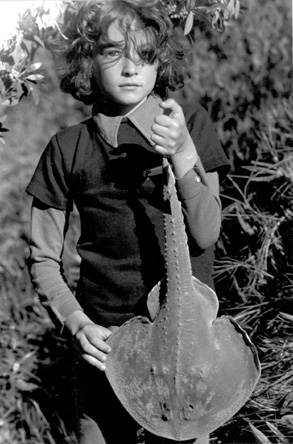January 2010
I'm pleased to announce ...
TheSharkDoctor's

Collector Of The Year

2009
Senior Collections Manager
Department of Ornithology & Mammalogy
California Academy of Sciences

Dr. Long lurked in The Shadows all year, patiently waiting for
Something-Of-Interest to surface from TheSharkDoctor's
Surgery ... Then WHACKO! He'd attack. His interest in specimens
ranged from "Mrs. Long Tooth" { a WHOPPER M.Q. Mako } - And
"The StigMako" { perhaps the largest Male Mako ever captured,
at over 13 feet, this jaw just kept oozing ferrous liquids
from It's upper symphysis, WOW quite freaky really! } ... To
Duskys with a mouthful of broken teeth. His Research involves Shark
attacks on mammals, particularly in identifying the Shark species
responsible. As the resultant damage from the attack is not created
by Sharks with "Museum-Quality" dentition, then jaws with broken teeth
take on a critical role in helping to ID the Shark involved. Of course most
Collectors want pristine Specimens, so I was quite pleased to have a
real Scientist find usage in my 'Grade B" jaws.
THANKS VERY MUCH DOC FOR ALL OF YOUR
PURCHASES THROUGHOUT 2009, I REALLY APPRECIATE
EACH AND EVERY ONE OF THEM.
Best Fishes for 2010
AN INTERVIEW WITH THE-GOOD-DOCTOR
"GREAT WHITE SHARKS"
IN REAL PLAYER FORMAT --- CLICK HERE
Excerpt from an interview with Dr. Doug:
" Some scientists spend their lives locked in the lab-coated towers of
academia, poking toothpicks into formaldehyde-soaked frogs. The Tentacle
Sessions has no patience for such people. We want to bring you scientists of
action, brave-hearted, brilliant, indefatigable super-humans equally at home
in the wildest of outbacks or the rowdiest of cocktail parties. And funny,
they have to be funny.

"The list of researchers who
would qualify today is brief, but if we could extend
our recruiting into the past
it would include the likes of Darwin, Livingston,
Feynman, Cousteau, Perkins,
and, of course, Boroditsky. It is a rare scientist
indeed who is fit for our forum."

"In June we featured Dr. Douglas
J Long who is indeed cut from that cloth,
made, it would seem, also from
that long-ago broken mold. Doug has traveled
in over 35 countries and studied
great white sharks, rattlesnakes, flesh-eating snails,
and deep-sea fishes. He is also
an expert in all manner of embryologic processes.
He is not your run-of-the mill
biologist, as you can tell by the company he keeps."
"Currently working for the California
Academy of Sciences, Doug serves as
acting chairman of the Department
of Ornithology & Mammalogy and
also the Collections Manager
for the department. Which means that he
spends his time traveling the
globe charting and collecting the animals
of the world. He has discovered
over a dozen previously unknown species of
animals and amassed thousands
of slides and some incredible stories
in his travels."

"Doug's travels have included
expeditions to the Golden Triangle
(Burma, Laos & Thailand),
New Zealand, Patagonia (Chile & Argentina), and the
Gulf of Guinea (western Africa).
His adventures included side-stepping cobras, a
voiding landmines, rum-loving
elephants, CIA operatives, rebel insurgencies,
malaria epidemics, and drinking
alcohol in the most unexpected places.
He also gave details of the
fauna and culture of the countries and some of the
challenges that wildlife conservation
faces in each of them."
"It was an incredible night.
The audience left thoroughly entertained and more
knowledgeable for the experience.
We actually had to cut the post-show Q&A
short, eventually, as it was
getting late. Doug just has too many great stories
to cover in one sitting. And
that doesn't even count his hobbies."

The Good Dr. says:
"Here I am inspecting a live
Galapagos Sea Lion on the Galapagos
Islands that has been bitten by
a silver-tipped shark on its rump. This is a
very rough climate I have
to deal with in conducting my research.
Yea Doc, It looks rough hehehehee
I collect shark jaws for three
areas of research: 1) Shark predation on marine
mammals, and analysis of the size
and spacing of the teeth, and serrations are
valuable for identifying which
species prey on marine mammals; 2) taxonomic
studies on the evolution of sharks
can often rely on tooth and dental system
morphologies to show relationships
between different groups of sharks;
and 3) Paleontology and evolution
of sharks is largely based on the
identification of fossil teeth,
and knowledge of present-day shark tooth
morphology & feeding adaptations
can tell a lot about how sharks have
evolved and changed over time."
WOW! AN AMAZING
DOCTOR-OF-
ALL-THINGS!
And an inspiration
to us all .
THE ETERNAL QUESTION:
ARE SCIENTISTS MADE ?
OR BORN ??

DOUGLAS AT 7 YEARS OF AGE
SEEMS GENETIC TO ME !

Click Here To Go To
TheSharkDoctor's
"Collector's Window"
And See Some Fabulous Collections Of Shark Jaws And Teeth